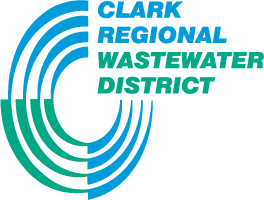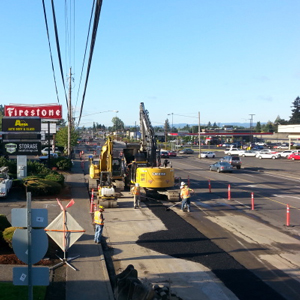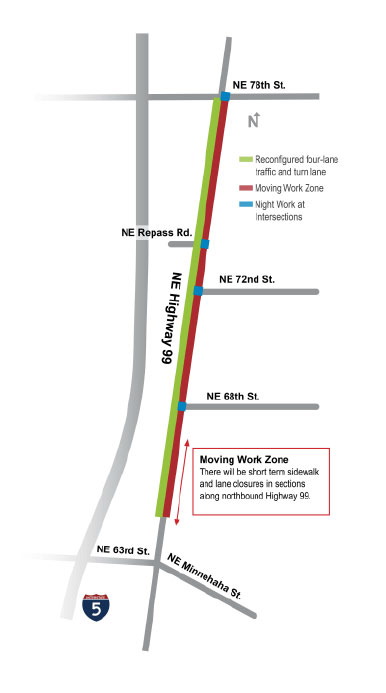Highway 99 Sewer South Replacement
An Important Investment in Hazel Dell’s Economic Future
Clark Regional Wastewater District replaced its sanitary sewer pipe along Highway 99, between NE 63rd Street and NE 78th Street, as part of a proactive effort to keep our sewer system operating safely and efficiently.
The existing sewer line, which is located along the eastern side of the road and serves adjacent businesses, was aging and needed replacement. The District’s proactive maintenance and asset management program identified the need to replace the existing pipe in order to ensure continued reliable service. The original pipe was installed in the late 1960s and has slowly deteriorated over time, requiring additional maintenance. This investment in new sewer infrastructure will provide continued reliable, efficient service for our Hazel Dell customers for another 50 years, while at the same time protecting public health and the environment.
Construction to replace the sewer pipe typically consists of digging a trench, laying pipe, backfilling, and paving. There will also be manhole installation, reconnection of sewer laterals to businesses, a segment of waterline replacement and other work. In most cases, work will be confined to the right hand northbound travel lanes and sidewalk. Temporary lane closures will occur in short segments along the corridor within the construction zone.
Careful planning has gone into this project to minimize loss of sewer service to businesses. To accomplish that, the new sewer pipe will be placed adjacent to the old, existing pipe, which will remain in operation during construction and then be abandoned. However, corridor businesses can expect moderate traffic impacts along with some noise, vibration and dust in areas under construction.
Construction Impacts
Careful planning went into this project to minimize impacts to local businesses and the public. To maintain sewer service for businesses, the new sewer pipe was placed adjacent to the old, existing pipe. The existing pipe remained in operation during construction and was then abandoned.
Planners expected moderate traffic impacts along with some noise, vibration and dust in areas under construction. Traffic revisions accommodated the construction work zone.
Traffic Impacts
During construction, Highway 99 was restriped within the project area in order to maintain four lanes of traffic and a center turn lane. The new striping pushed all lanes to the west and temporarily removed the bike lanes. Traffic was delayed at various times due to temporary sidewalk and lane closures. Flaggers were present to direct drivers.
Vehicular access to businesses was maintained during regular business hours. Driveway access was temporarily blocked in front of businesses with more than one driveway. The contractor provided businesses at least two business days’ notice prior to working in front of their driveway. In most cases, the contractor was in front of each business three times: first, to construct the sewer main (two to four days); second, to construct the sewer service lateral (a day); and third, to do final paving, concrete restoration and restriping (a day or less). Some areas required additional work. Any portions of driveways or sidewalks removed by construction were replaced.
Schedule
Construction began in May 2016 and continued through October 2016. Not all areas were under construction at the same time. Work was done in stages.
Frequently Asked Questions
Click the headings below for more details.



